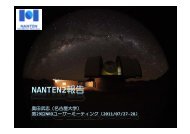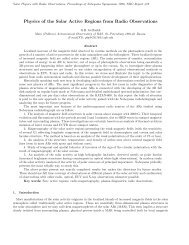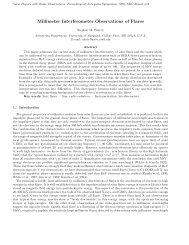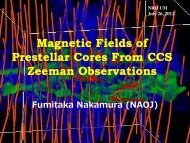CASA (45m filer)によるポジションスイッチデータの解析
CASA (45m filer)によるポジションスイッチデータの解析
CASA (45m filer)によるポジションスイッチデータの解析
- No tags were found...
Create successful ePaper yourself
Turn your PDF publications into a flip-book with our unique Google optimized e-Paper software.
<strong>CASA</strong> (<strong>45m</strong> <strong>filer</strong>)によるポジションスイッチデータの 解 析2013.4.12Yoshito Shimajiri (NRO)本 マニュアルで 記 述 した 解 析 方 法 は、 下 記 の version で 動 作 確 認 済 みです。○version 4.1[ 概 要 ]この 資 料 の 構 成 は 以 下 である。1. OTF データの 解 析 手 順[STEP1] <strong>CASA</strong> のバージョンの 確 認[STEP2] Initial flag[STEP3] Baseline Calibration[STEP4] データの 足 し 合 わせ[STEP5] スペクトルの 出 力2. ポジションスイッチデータの 解 析 パラメータの 詳 細
1. ポジションスイッチデータの 解 析 手 順[STEP1] <strong>CASA</strong> のバージョンが 4.1 であることを 確 認ターミナル 上 で casapy を 起 動 し、version が 4.1.0 であることを 確 認 。>casapy><strong>CASA</strong> Version 4.1.0 (r23507)← r23507 以 降 のバージョンであることを 確 認Compiled on: Tue 2013/04/02 22:02:21 UTC[STEP2] Initial flagバンドの 端 は 感 度 が 悪 いので 最 初 に flag。 同 様 な 方 法 でスプリアスの 除 去 等 も 行 うことが 可 能 。<strong>CASA</strong> : default(sdflag)<strong>CASA</strong> : infile ='ORI13C2.101231185510.01.nqm' ← 任 意 の 入 力 ファイル 名 を 指 定 。<strong>CASA</strong> : maskflag=[[0,300],[3796,4095]] ←flag 範 囲 を channel で 指 定 。<strong>CASA</strong> : iflist=[0] ← 解 析 したい IF 番 号 を 指 定 。<strong>CASA</strong> : outfile='ORI13C2.101231185510.01.nqm.IF0.f' ← 任 意 の 出 力 ファイル 名 を 指 定 。<strong>CASA</strong> : go[STEP3] Baseline Calibrationベースライン 補 正 を 行 う。オプション maskmode で、フィッティングモードを 任 意 のモードを 選 択 することが 出 来 る。また、オプション blfunc で、 任 意 のフィッティング 関 数 を 選 択することが 出 来 る。[maskmode について]○auto: 自 動 的 に emission free channel を 同 定 してフィッティング。○list: masklist で 指 定 した 範 囲 を emission free channel としてフィッティング。○Interactive: window 上 で interactive に emission free channel を 選 択 できる。<strong>CASA</strong> : default(sdbaseline)<strong>CASA</strong> : infile='ORI13C2.101231185510.01.nqm.IF0.f' ← 任 意 の 入 力 ファイル 名 を 指 定 。<strong>CASA</strong> : order = 1 ←fitting order を 指 定 。
<strong>CASA</strong> : outfile ='ORI13C2.101231185510.01.nqm.IF0.f.b' ← 任 意 の 出 力 ファイル 名 を 指 定 。<strong>CASA</strong> : iflist=[0] ← 解 析 したい IF 番 号 を 指 定 。<strong>CASA</strong> : go[STEP4] スペクトルの 足 し 合 わせここまでは 各 on 点 のデータ 毎 に 処 理 を 行 ってきた。ここでは 複 数 の on 点 データを1つのスペクトルにまとめる。この 作 業 を[STEP3]のベースライン 補 正 の 前 に 行 ってもよい。<strong>CASA</strong> : default(sdcal)<strong>CASA</strong> : specunit='GHz' ← 任 意 の 単 位 を 選 択<strong>CASA</strong> : infile='ORI13C2.101231185510.01.nqm.IF0.f.b' ← 任 意 の 入 力 ファイル 名 を 指 定 。<strong>CASA</strong> : outfile='ORI13C2.101231185510.01.nqm.IF0.f.b.c'← 任 意 の 出 力 ファイル 名 を 指 定 。<strong>CASA</strong> : scanaverage=True ← 各 scan を average<strong>CASA</strong> : timeaverage=True ← 各 時 間 のデータを average<strong>CASA</strong> : tweight='tsys' ← average の 際 、tsys の2 乗 比 の 重 みで 補 正 。<strong>CASA</strong> : iflist=[0] ← 解 析 したい IF 番 号 を 指 定 。<strong>CASA</strong> : go[STEP5] スペクトルの 出 力解 析 したスペクトルを 任 意 の 形 式 で 出 力 する。ここでは、ASCII ファイルで 出 力 をしている。このタスク(sdsave)では、specunit オプションが 用 意 されていないので、 任 意 の 単 位 で 出力 するためには、この 前 の STEP までに specunit を 選 択 しておく 必 要 があることに 注 意 。<strong>CASA</strong> : default(sdsave)<strong>CASA</strong> : infile='ORI13C2.101231185510.01.nqm.IF0.f.b.c' ← 任 意 の 入 力 ファイル 名 を 指 定 。<strong>CASA</strong> : outfile='ORI13C2.101231185510.01.nqm.IF0.f.b.c.s'← 任 意 の 出 力 ファイル 名 を 指 定 。<strong>CASA</strong> : tweight='tsys'<strong>CASA</strong> : timeaverage=False<strong>CASA</strong> : scanaverage=True<strong>CASA</strong> : iflist=[0] ← 解 析 したい IF 番 号 を 指 定 。<strong>CASA</strong> : outform = 'ASCII'<strong>CASA</strong> : go
2. ポジションスイッチデータの 解 析 パラメータの 詳 細下 記 に 各 STEP での 詳 細 なパラメータをまとめた。 青 字 はユーザーが 入 力 するパラメータである。[STEP2] Initial flag<strong>CASA</strong> : inp--------> inp()# sdflag :: ASAP SD spectral flagging taskinfile= 'ORI13C2.101231185510.01.nqm' # name of input SD datasetantenna = 0 # antenna name or id (only effective for MS input)specunit = '' # units for spectral axis (channel,km/s,GHz)frame = '' # frequency reference frame, e.g. LSRK (=current)doppler = '' # doppler convention, e.g. RADIO (=current)scanlist = [] # list of scans to use (e.g. [1,2,3,4])field = '' # string for selection by source nameiflist = [0] # list of IF ids to select (e.g. [0,1])pollist = [] # list of polarization by ids or names to select (e.g.# [0,1])maskflag= [[0, 300], [3796, 4095]] # list of mask regions to flag/unflagflagrow = [] # list of row numbers to apply row-based flagging/unflaggingclip = False # flag data outside a specified rangeflagmode = 'flag' # flag mode (flag,unflag)interactive = False # determines interactive flaggingoutfile= 'ORI13C2.101231185510.01.nqm.IF0.f' # name of output file (See a WARNING in# help document)outform = 'ASAP' # output file format (ASCII,MS,SDFITS,ASAP) (See a WARNING# in help document)overwrite = True # overwrite the output file if already exists (See a WARNING# in help document)plotlevel = 0 # control for plotting of resultsasync = False # If true the taskname must be started using sdflag(...)
[STEP3] Baseline Calibration<strong>CASA</strong> : inp(sdbaseline)---------> inp()# sdbaseline :: ASAP SD task: fit/subtract a spectral baselineinfile= 'ORI13C2.101231185510.01.nqm.IF0.f' # name of input SD datasetantenna = 0 # antenna name or id (only effective for MS input)fluxunit = '' # units for line flux (K,Jy) (=current)specunit = '' # units for spectral axis (channel,km/s,GHz)frame = '' # frequency reference frame, e.g. LSRK (=current)doppler = '' # doppler convention, e.g. RADIO (=current)scanlist = [] # list of scans to use (e.g. [1,2,3,4])field = '' # string for selection by source nameiflist = [0] # list of IF ids to select (e.g. [0,1])pollist = [] # list of polarization ids to select (e.g. [0,1])tau = 0.0 # atmospheric optical depth for correctionmasklist = [] # list or string of mask regions to INCLUDE in BASELINE fitmaskmode = 'auto' # mode of setting additional channel masksthresh = 5.0 # S/N threshold for linefinderavg_limit = 4 # channel averaging for broad linesedge = [0] # channels to drop at beginning and end of spectrumblfunc = 'poly' # baseline model functionorder = 1 # order of baseline polynomialverify = False # verify the results of baseline fitting (only for blfunc="poly")verbose = True # output fitting results to loggerbloutput = True # output fitting results to a text fileblformat = '' # format of the text file specified with bloutputshowprogress = True # show progress status for large dataminnrow = 1000 # minimum number of input spectra to show progress statusoutfile= 'ORI13C2.101231185510.01.nqm.IF0.f.b' # output file name
outform = 'ASAP' # output file format (ASCII,MS,SDFITS,ASAP)overwrite = False # overwrite the output file if already existsplotlevel = 0 # plot results (0=none,1+=some, inp()# sdcal :: ASAP SD task: do data selection, calibration, and averaginginfile= 'ORI13C2.101231185510.01.nqm.IF0.f.b' # name of input SD datasetantenna = 0 # antenna name or id (only effective for MS input)fluxunit = '' # units for line flux (K,Jy) (=current)specunit = 'GHz' # units for spectral axis (channel,km/s,GHz,=current)frame = '' # frequency reference frame, e.g. LSRK (=current)doppler = '' # doppler convention, e.g. RADIO (=current)calmode = 'none' # SD calibration mode (ps,nod,otf,otfraster,fs,fsotf,quotient,none)scanlist = [] # list of scans to use (e.g. [1,2,3,4])field = '' # string for selection by source nameiflist = [0] # list of IF ids to select (e.g. [0,1])pollist = [] # list of polarization ids to select (e.g. [0,1])channelrange = [] # channel range selection (e.g. [0,5000])scanaverage = True # average integs within scans (True,False)timeaverage = True # average scans over time (True,False)tweight = 'tsys' # weighting for time averagingaverageall = False # set True only when averaging spectra with different# spectral resolutionspolaverage = False # average over polarizations (True,False)tau = 0.0 # atmospheric optical depth for correctionverify = False # verify the results of calibrationoutfile= 'ORI13C2.101231185510.01.nqm.IF0.f.b.c' # output file nameoutform = 'ASAP' # output file format (ASCII,MS,SDFITS,ASAP)
overwrite = False # overwrite the output file if already existsplotlevel = 0 # plot results (0=none,1+=some, inp()# sdsave :: ASAP SD task: save the sd spectra in various formatinfile= 'ORI13C2.101231185510.01.nqm.IF0.f.b.c' # name of input SD datasetantenna = 0 # antenna name or id (only effective for MS input)getpt = True # fill DIRECTION column properly, or reuse POINTING table in# original MS (only effective for MS input)rowlist = [] # list of row numbers to process (e.g. [0,2,4,6])scanlist = [] # list of scan to process (e.g. [20,21,22,23])field = '' # string for selection by source nameiflist = [0] # list of IF ids to select (e.g. [0,1])pollist = [] # list of polarization ids to select (e.g. [0,1])scanaverage = False # average integs within scans (True,False)timeaverage = True # average scans over time (True,False)tweight = 'tsys' # weighting for time averagingpolaverage = False # average over polarizations (True,False)restfreq = '' # rest frequency (default unit: Hz)outfile= 'ORI13C2.101231185510.01.nqm.IF0.f.b.c.s' # output file nameoutform = 'ASCII' # output file format (ASCII,MS2,SDFITS,ASAP)overwrite = False # overwrite the output file if already existsasync = False # If true the taskname must be started using sdsave(...)














